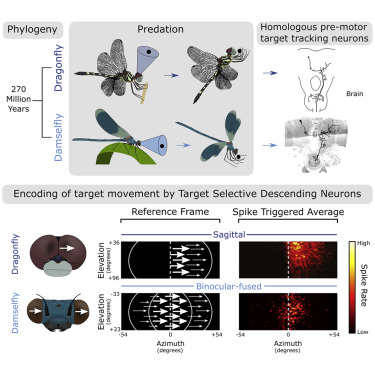当前位置:
X-MOL 学术
›
Curr. Biol.
›
论文详情
Our official English website, www.x-mol.net, welcomes your
feedback! (Note: you will need to create a separate account there.)
Binocular Encoding in the Damselfly Pre-motor Target Tracking System.
Current Biology ( IF 8.1 ) Pub Date : 2020-01-09 , DOI: 10.1016/j.cub.2019.12.031 Jack A Supple 1 , Daniel Pinto-Benito 1 , Christopher Khoo 1 , Trevor J Wardill 2 , Samuel T Fabian 1 , Molly Liu 3 , Siddhant Pusdekar 3 , Daniel Galeano 3 , Jintao Pan 4 , Shengdian Jiang 4 , Yimin Wang 5 , Lijuan Liu 4 , Hanchuan Peng 4 , Robert M Olberg 6 , Paloma T Gonzalez-Bellido 3
Current Biology ( IF 8.1 ) Pub Date : 2020-01-09 , DOI: 10.1016/j.cub.2019.12.031 Jack A Supple 1 , Daniel Pinto-Benito 1 , Christopher Khoo 1 , Trevor J Wardill 2 , Samuel T Fabian 1 , Molly Liu 3 , Siddhant Pusdekar 3 , Daniel Galeano 3 , Jintao Pan 4 , Shengdian Jiang 4 , Yimin Wang 5 , Lijuan Liu 4 , Hanchuan Peng 4 , Robert M Olberg 6 , Paloma T Gonzalez-Bellido 3
Affiliation

|
Akin to all damselflies, Calopteryx (family Calopterygidae), commonly known as jewel wings or demoiselles, possess dichoptic (separated) eyes with overlapping visual fields of view. In contrast, many dragonfly species possess holoptic (dorsally fused) eyes with limited binocular overlap. We have here compared the neuronal correlates of target tracking between damselfly and dragonfly sister lineages and linked these changes in visual overlap to pre-motor neural adaptations. Although dragonflies attack prey dorsally, we show that demoiselles attack prey frontally. We identify demoiselle target-selective descending neurons (TSDNs) with matching frontal visual receptive fields, anatomically and functionally homologous to the dorsally positioned dragonfly TSDNs. By manipulating visual input using eyepatches and prisms, we show that moving target information at the pre-motor level depends on binocular summation in demoiselles. Consequently, demoiselles encode directional information in a binocularly fused frame of reference such that information of a target moving toward the midline in the left eye is fused with information of the target moving away from the midline in the right eye. This contrasts with dragonfly TSDNs, where receptive fields possess a sharp midline boundary, confining responses to a single visual hemifield in a sagittal frame of reference (i.e., relative to the midline). Our results indicate that, although TSDNs are conserved across Odonata, their neural inputs, and thus the upstream organization of the target tracking system, differ significantly and match divergence in eye design and predatory strategies. VIDEO ABSTRACT.
中文翻译:

豆娘前运动目标跟踪系统中的双目编码。
类似于所有的豆娘,Calopteryx(家蝇科)通常被称为宝石翅膀或闺女,拥有分裂的(分开的)眼睛,视野重叠。相比之下,许多蜻蜓物种具有双眼重叠有限的独眼(背融合)眼。我们在这里比较了豆娘和蜻蜓姐妹血统之间目标追踪的神经元相关性,并将这些视觉重叠变化与运动前神经适应联系起来。尽管蜻蜓背对猎物进行攻击,但我们证明了闺女正面对猎物进行攻击。我们鉴定出具有与匹配的额叶视域在解剖学和功能上与背侧蜻蜓TSDN同源的额叶视感受器的闺女目标选择性下降神经元(TSDN)。通过使用眼罩和棱镜操纵视觉输入,我们证明了运动前水平的运动目标信息取决于闺女的双目总和。因此,脱毛肌在双眼融合的参考系中编码方向信息,以使向左眼中线移动的目标的信息与向右眼中线移动的目标的信息融合。这与蜻蜓TSDN相反,在蜻蜓TSDN中,感受野具有尖锐的中线边界,将响应限制在矢状参考系(即相对于中线)中对单个视觉半场的响应。我们的结果表明,尽管TSDN在整个Odonata中均得到保守,但它们的神经输入以及目标跟踪系统的上游组织却显着不同,并且在眼图设计和掠食性策略上相符。视频摘要。
更新日期:2020-01-16
中文翻译:

豆娘前运动目标跟踪系统中的双目编码。
类似于所有的豆娘,Calopteryx(家蝇科)通常被称为宝石翅膀或闺女,拥有分裂的(分开的)眼睛,视野重叠。相比之下,许多蜻蜓物种具有双眼重叠有限的独眼(背融合)眼。我们在这里比较了豆娘和蜻蜓姐妹血统之间目标追踪的神经元相关性,并将这些视觉重叠变化与运动前神经适应联系起来。尽管蜻蜓背对猎物进行攻击,但我们证明了闺女正面对猎物进行攻击。我们鉴定出具有与匹配的额叶视域在解剖学和功能上与背侧蜻蜓TSDN同源的额叶视感受器的闺女目标选择性下降神经元(TSDN)。通过使用眼罩和棱镜操纵视觉输入,我们证明了运动前水平的运动目标信息取决于闺女的双目总和。因此,脱毛肌在双眼融合的参考系中编码方向信息,以使向左眼中线移动的目标的信息与向右眼中线移动的目标的信息融合。这与蜻蜓TSDN相反,在蜻蜓TSDN中,感受野具有尖锐的中线边界,将响应限制在矢状参考系(即相对于中线)中对单个视觉半场的响应。我们的结果表明,尽管TSDN在整个Odonata中均得到保守,但它们的神经输入以及目标跟踪系统的上游组织却显着不同,并且在眼图设计和掠食性策略上相符。视频摘要。











































 京公网安备 11010802027423号
京公网安备 11010802027423号